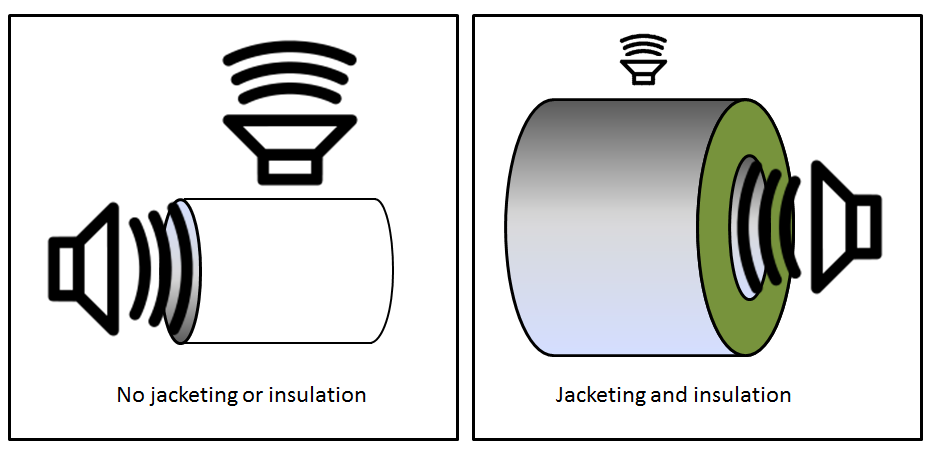Insulation isn’t just about thermal performance; it’s also about acoustical control. In industrial settings, where every-day operations create an impressive amount of noise pollution, acoustical control can be a priority. There are a number of different methods to approach sound control, and we addressed two of them in a previous blog, Reduce Noise with Sound-Proofing Insulation. The two acoustical control basics we discussed were sound absorption, the ability to reduce reverberation in environments where surfaces reflect sound, and sound transmission loss, the ability to reduce sound traveling through a material. The third function that plays into acoustical control is the concept of insertion loss. Insertion loss refers to reducing sound by adding insulation, jacketing/lagging, or both to a pipe or duct system to prevent sound from traveling outward. You may think it sounds similar to transmission loss, and it should. Insertion loss and transmission loss are essentially the same thing, except that insertion loss refers to a acoustical control treatment or material that is added to a base or control system while transmission loss measures sound traveling through partitions, which is a single system measured independently as a single component. Though insertion loss applies to both pipes and ducts, for the sake of this article, we will use the generic term pipe to mean both.
We determine insertion loss by using ASTM E1222, “Standard Test Method for Laboratory measurement of the Insertion Loss of Pipe Lagging Systems,” a test method that measures the sound emitted from a base (non-insulated) system and a lagged (insulated) system. Essentially, the base system operates as the control by which we measure the difference in sound between the two systems. The difference in ambient (outside) noise levels between the base and lagged systems is the insertion loss. The pipe system is tested by energizing the inside of the pipe with a reference sound source. The sound level outside the pipe is then measured in decibels and recorded. Then the insulation and jacketing are applied to the system, the inside of the pipe is re-energized to the same sound level as before, and the measurements are taken a second time. When the test is complete, the outputs are compared at each frequency to establish the insertion loss. The greater the difference between the two measurements, the higher the insertion loss – meaning that the insulation is doing a better job at reducing the sound traveling through it. Once we have these values, we can use them to determine what insulation thicknesses is appropriate to obtain the desired level of acoustical performance.
Jacketing and lagging also play a large part in attenuating or dissipating sound energy. Thicker jacketing, bitumen-based free damping layers, visco elastic polymer damping compounds, and high mass per unit-area sheets of limp rubber or plastic can be used to improve acoustical performance. The additional mass that has been added to the system improves its ability to reduce low frequency noise. Thus jacketing/lagging weights should also be taken into account when addressing acoustical control.

If our primary aim is acoustical control, then the insulation we select should be fibrous in nature. A fibrous insulation system makes it more difficult for vibration from the pipe to be transferred through the insulation by providing additional resistance along the paths that the sound waves travel. This is why mineral wool and fiber glass insulations work particularly well for acoustical control. Additionally, the thickness of the insulation plays a critical role in the insertion loss; the thicker the insulation, the higher the insertion loss, and the better the acoustical performance of the insulation system. (1)
While it may seem reasonable to assume that rigid insulations might also have a high insertion loss because of their solidity, the opposite is actually true. Rigid insulations such as calcium silicate, perlite and foams tend to transfer sound energy more readily through vibrations because of their higher compressive strength and rigidity. Generally speaking, the higher the density of the insulation, the more readily sound energy can be transferred through the material. (1)
When we look at designing insulation systems for industrial settings, it’s important to understand how different insulations behave in varying environments so that we can select the best insulation material for the application. Look for part two of this blog in October, where we will discuss how to use insertion loss and sound absorption to determine what performance levels can be expected from a mineral pipe insulation with metal jacketing.
- ISO 15665:2003 section 6.3 “Acoustics — Acoustic insulation for pipes, valves and flanges.”
